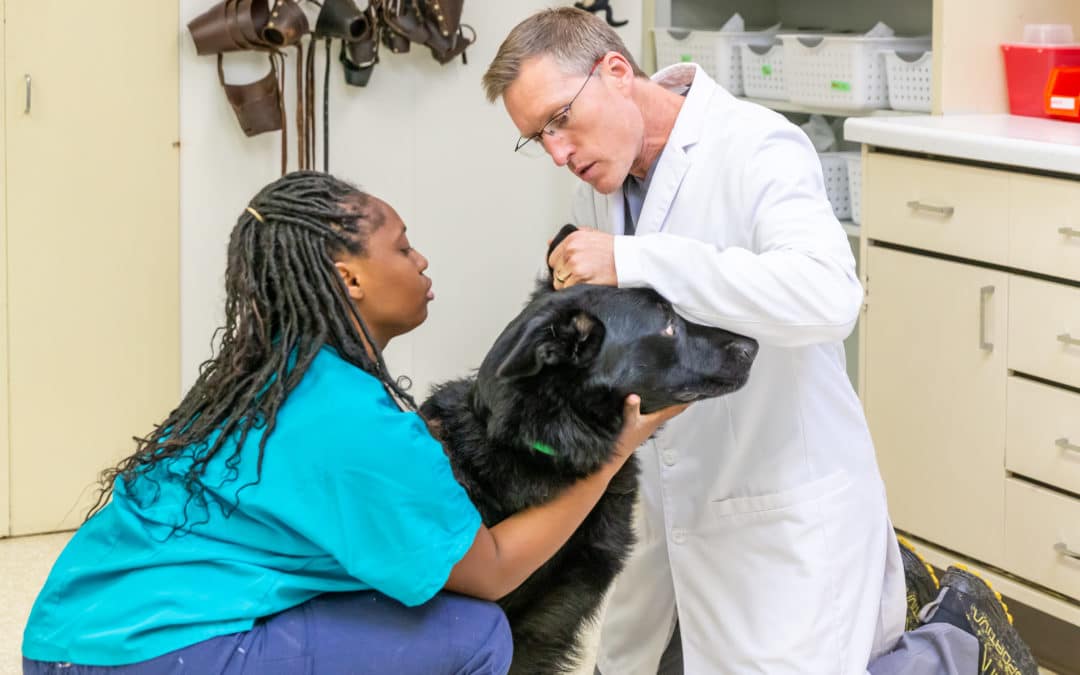Dog ear mites vs yeast infection, which does your dog have? How do you treat them? It is vital to identify, manage, and treat ear mites or yeast infections in dogs. The best way to identify them is by monitoring your dog and paying extra attention whenever they seem irritable or ill.
Paying attention to and managing your dog’s health and well-being can increase the number of years they live and improve their emotional health, among other things. If you notice your dog constantly shaking its head, scratching its ears, or flattening its ears back, it might have a yeast infection or ear mites.
Dog Ear Mites vs Yeast Infection
Table of Contents
- 1 Dog Ear Mites vs Yeast Infection
- 2 What Are Ear Mites?
- 3 How Do Dogs Get Ear Mites?
- 4 Canine Mites Contagious
- 5 How to Treat Ear Mite Infestations
- 6 What is a Yeast Infection?
- 7 Causes for Yeast Infection in Dogs
- 8 How to Treat a Yeast Infection
- 9 How to Prevent Yeast Infections in Dogs
- 10 At Home Care For Your Pet’s Ears
- 11 Does My Dog Have an Ear Infection?
- 12 Can Allergies Cause an Ear Infection in Dogs?
- 13 Can a Dog Die From an Ear Infection?
- 14 Conclusion
How can you tell the difference between ear mites and ear infections in dogs? Ear mites and yeast infections have some similar symptoms, so sometimes, it’s hard to decipher between them. Puppies are usually more prone to ear mites than adult dogs.
Yeast infections, on the other hand, happen in both puppies and adult dogs. There are many different reasons a dog can have a yeast infection, including genetics and allergies. Yeast infections usually cause head shaking, redness, odor, itching, and a brown discharge.
Your veterinarian can determine if your dog’s ear issues are because of mites or yeast by taking an ear swab and viewing it with a microscope. Keep reading as we break the symptoms of dog ear mites vs ear infections down:
What Are Ear Mites?
Ear mites are parasites that are hard to get rid of and almost impossible to see without a microscope. When you view an ear mite under a microscope, you’ll most likely see a tiny parasite with eight legs.
They are particularly fond of staying in a dog’s ear canal. Ear mites cause infection and inflammation in the ear canal. Dogs are usually affected by the Otodectes cynotis, which is classified as a type of mange.
Although they’re called ear mites, these parasites don’t limit their feeding to the ears, as they quickly spread around your dog’s body. If a dog has ear mites and it isn’t treated quickly, the ear mites can go into its skin and damage its hair follicles which can lead to hair loss.
How Do Dogs Get Ear Mites?
Most times, dogs get ear mites from other animals. They are one of the most contagious parasites, and they easily move between pets. Ear mites don’t seem to like humans, and the likelihood of a human picking up ear mites is slim.
Ear mites are more common in puppies because their immune systems are still fragile. Dogs can get ear mites from any animal; they can get it from playing with dogs, chasing rabbits, but most times, they get ear mites from cats.
Cats usually suffer from ear mites because they are the best hosts. The ear mites infiltrate their ear canals and lay eggs. A cat can then spread the ear mites to your dog when your dog is chasing it or playing with it.
Canine Mites Contagious
The first sign you might notice that shows your dog has an ear mite is itching its ears and rubbing its head. You might also find your dog shaking its head continuously as if it’s trying to get something out of it.
Some dogs find an infestation of ear mites as a slight irritation, but now sensitive ones can experience a raging battle with more severe symptoms. A dog can scratch so much that it creates a painful hematoma (blood blister) on the ear that needs to be seen by a vet.
You might notice these physical symptoms as well: swelling, reddish ear wax, and redness. These symptoms are similar to yeast infections, but a significant difference is the dark granules in your dog’s ears that resemble coffee grounds. These granules are ear mite discharge.
How to Treat Ear Mite Infestations
If you want to treat an ear mite infection, you have to clean your dog’s ears and get rid of the mites in your dog’s ear canal. You’ll need an ear flush to do that. You can consult your veterinarian for the type of ear flush to use for your dog.
Put the flush in your dog’s ear and massage its base for about thirty seconds while keeping a firm grip on its head. After you massage your dog’s ear, let it go, and it’ll shake its head to remove the liquid. It’s best to do this outside as it can get a little messy.
Once you’re done cleaning your dog’s ear, wipe it with cotton balls and repeat the process until there’s nothing left to remove. You could ask your vet for some antiparasitic lotion to protect your dog while it recovers.
After you’ve treated your dog, make sure to deep clean your house because ear mites are quite contagious, and they can still be in your dog’s bedding. It would help if you also treat other pets in your home.
What is a Yeast Infection?
Dogs are prone to ear infections, and these infections are usually quite painful. Yeast infections in dogs are caused by a fungus known as Malassezia pachydermatis. Dogs with demodectic mange have a higher probability of having ear yeast infections because M. pachydermatis is the same fungus that causes mange-based infections in the skin.
Causes for Yeast Infection in Dogs
Yeast infections are caused by many reasons, but it’s always because the yeast is somewhere it’s not meant to be. Dog ears are the perfect environment for yeast infections because they’re moist and warm.
These characteristics make it easy for the yeast to multiply and snowball. The yeast infection can lead to allergies, bacterial infections, and other opportunistic infections.
Most times, yeast infections are caused by excess moisture in your dog’s ear. If your dog just got bathed, went swimming, or running, it could develop a yeast infection.
How to Treat a Yeast Infection
What kills yeast infection in dogs’ ears? To treat a yeast infection, you’ll have to flush your dog’s ears. Vets recommend bathing your dog before its ears are flushed. It would be best if you used a medicated anti-fungal shampoo to wash your dog and remove as much discharge as you can from its ears.
Once you’ve rinsed your dog’s ear out, towel-dry it and use a boracetic ear flush. The ear flush contains acids that work against fungi, yeast, and bacteria and dry your dog’s ear out. The best thing to do is use ear flushes whenever your dog goes into water to prevent a yeast infection.
An alternative to using liquid ear flushes is to use a chewable. One good example is the Bravecto chewable. There have been some rumors that this drug kills dogs, but they have all been proven false.
How to Prevent Yeast Infections in Dogs
To prevent yeast infections in your dog, you have to know the cause of yeast infections in the first place. It would be best if you routinely bathed your dog with an antifungal shampoo. For it to be most effective, let the shampoo lather stay on your dog’s for at least 10 minutes before finding it off.
If your dog has skin folds, it will need more maintenance treatment to prevent the folds from being too moist or warm since yeast thrives in damp places.
At Home Care For Your Pet’s Ears
Checking and cleaning its ears regularly is one of the best ways to keep your dog healthy and happy. These are some of the best ways to take care of your dog’s ears at home:
- Check its ears for loose fluid, residue, or dirt, and gently clean it out with some cotton.
- Put a finger in front of your dog’s ear flap and your thumb behind it, then add ear cleaning solution in its ear canal.
- Massage its ear canal gently while applying the ear cleaner to your dog’s ear.
- After this, pick up another cotton ball and gently pat your dog’s ear canal to absorb ear wax and other dirt.
- Carry this process out as many times as necessary.
- When your dog’s ear is clean, get another cotton ball and gently pat its surface until it is totally dry.
- If your veterinarian prescribes any drugs, make sure your dog takes them.
Does My Dog Have an Ear Infection?
How will you know if your dog has ear mites or an ear infection when most of their symptoms are similar. Here are some ways to tell if your dog has an ear infection:
- Redness
- A musty or bad odor from its ears
- Reddish or bloody discharge
- Swelling
Can Allergies Cause an Ear Infection in Dogs?
Dogs that have allergies are more prone to ear infections than other dogs. You will know if the cause of your dog’s ear infections is allergies if it only flares up or worsens when your dog has contact with the allergen.
Can a Dog Die From an Ear Infection?
The likelihood of a dog dying from an ear infection is quite rare, but ear infections still cause severe and lasting damage. If you leave it untreated, an ear infection can cause permanent damage to your dog’s ears.
Some of the more extreme cases can damage its blood vessels and eardrums. Therefore, even though death is extremely rare in cases of ear infections, you should take care to treat them early because they can harm your dog for life.
Conclusion
Constant itching and head rubbing are uncomfortable for your dog, and it can be a sign of ear mites or a yeast infection. Although ear mites pose a slightly lower risk than yeast infections, it’s important to check the cause of your dog’s illness out and deal with it immediately.







